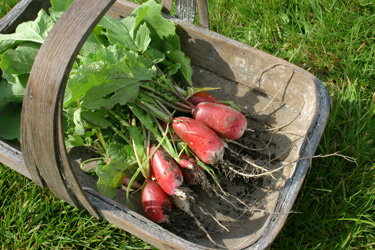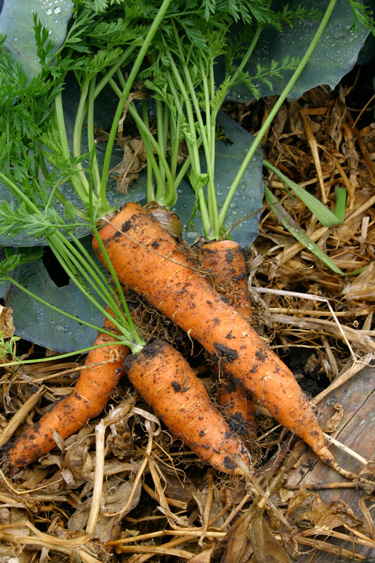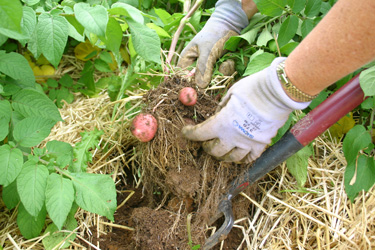10 crops for Christmas
Changes in weather patterns and with El Nino now in play, frosts and cool temperatures seem unlikley this spring. However, planting in haste during the first sunny spell could set your garden back as plants will struggle to bounce into life if there is a lingering chill of spring. Generally the last frosts are in October. Always keep an eye on the weather forecast and have the frost cloth ready for a late unexpected frost.
Sowing seeds on a warm window sill or in a greenhouse can give tender plants a great head start. By the time the ground warms up your seedlings should be ready to plant out.
| 1 | Microgreens are a quick and easy harvest and you don’t even need to go outside. Sow seeds on a sunny window sill and within two weeks you will have a nutrient dense crop to add zing to your meals. |
| 2 | Radish seeds can be sown directly in the soil throughout the spring months. The cool of spring provides ideal conditions. Radish will be ready to harvest after about six weeks. There are a range of exciting colours and shapes available to make a spring salad pop with colour and flavour. |
| 3 | Lettuces actually prefer the cool weather so spring is the perfect season for them. In as few as seven short weeks you will be able to enjoy a crisp spring salad. Lettuces will need to be protected from slugs and snails because they love them too. Sow more every two weeks for a continuous harvest. |
| 4 | Peas love cool weather and prefer to be planted out in spring. It is a great idea to plant more every three weeks throughout spring to ensure a continuous supply. The first pods should be ready to pick in about eight weeks. Make sure you harvest every pod or the plant will stop producing more. |
| 5 | Beetroot don’t mind it a bit cool and can be planted throughout spring and summer. Once they reach about the size of a golf ball they are ready to harvest. This takes about 8–10 weeks and if you sow seeds at regular intervals, you will have some ready for Christmas and beyond. |
| 6 | Zucchini are well known for their abundant growth, however won’t tolerate frost so it is important to wait for warm weather. Sow seeds indoors 3–4 weeks before the last frost date and they will be large enough to plant out in the garden once it’s safe. Within eight weeks you will have more zucchini than you know what to do with. |
| 7 | Carrots are a good staple crop and by selecting the right variety you should be able to grow them all year long. An early sowing directly into well drained fluffy soil in spring will result in delicious, crispy carrots in time for Christmas. These should take about 12–16 weeks. |
| 8 | Potatoes - seed potatoes can generally be planted two weeks before the last frost date as it takes about that long for them to emerge from the soil. Protect them from any unexpected late frosts by mounding up the soil over the leaves. This also protects the potatoes from being exposed to the sun and going green. Early crop potatoes such as Swift, Cliff Kidney, Rocket and Jersey Benne will be ready in under 100 days so if they are planted around mid-September there will be new potatoes on the Christmas table. |
| 9 | Cucumber planted too early will struggle to thrive, so waiting until mid October to plant seedlings in the garden is preferable to ensure healthy plants. The first crunchy cucumber should be found on the vine in plenty of time for the festive season. |
| 10 | Beans won’t germinate at less than 15°C and will rot in wet soil, so it pays to wait until spring warms up. However in 8–10 weeks you should begin to see the start of an abundant harvest, just in in time for Christmas. |
Once the festive season has passed you will be able to enjoy the full array of produce in your garden as tomatoes, sweetcorn and peppers begin to overflow your harvest basket.
Planning for a bountiful harvest
Before you even pick up your spade, decide what you want to grow in the space you have. Maximise your garden by planting lettuce in the shade of a tomato plant. Sow radishes close to carrots as they will be long gone by the time the carrots need the space. Sweetcorn, beans and squash grow really well together in the same space. Consider the possibility of container gardening to create or extend your garden.
Don’t be tempted to fill every available space, leave room for succession planting. Only plant as much lettuce as you will be able to eat in two weeks, and every two weeks you will have the freshest salads all summer.
Write it all down in a plan so when the time comes you will have a thriving garden giving you maximum harvest.

20-Sep-2023

Radishes

Peas in flower

Carrots

New potatoes

